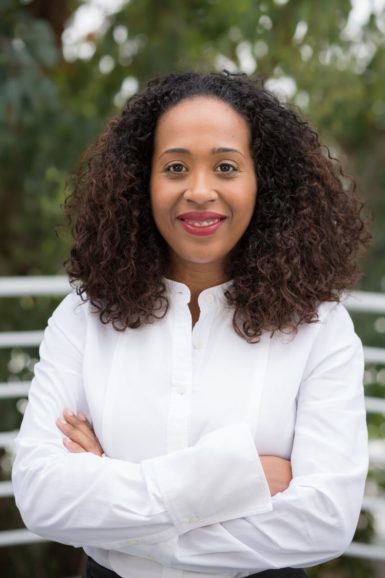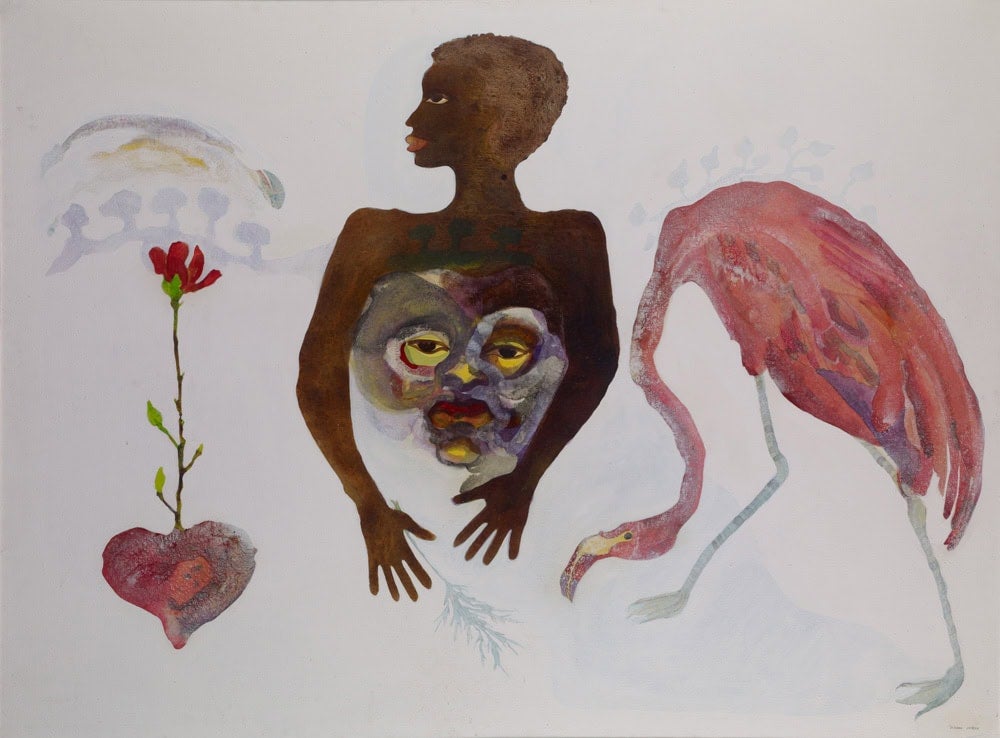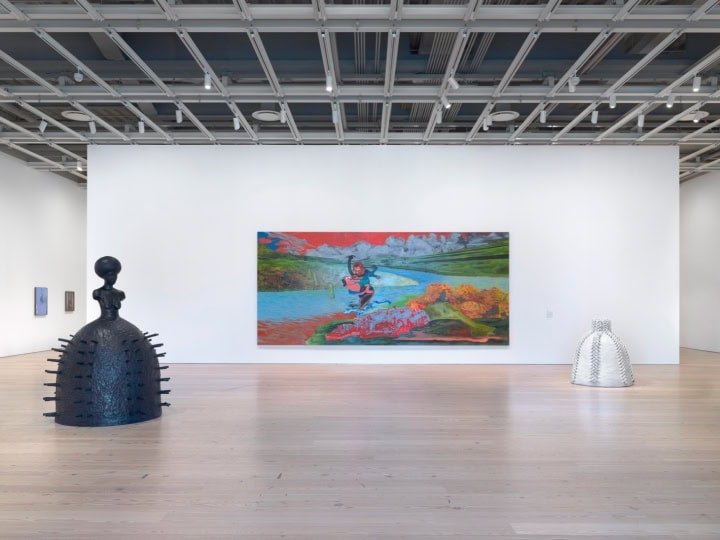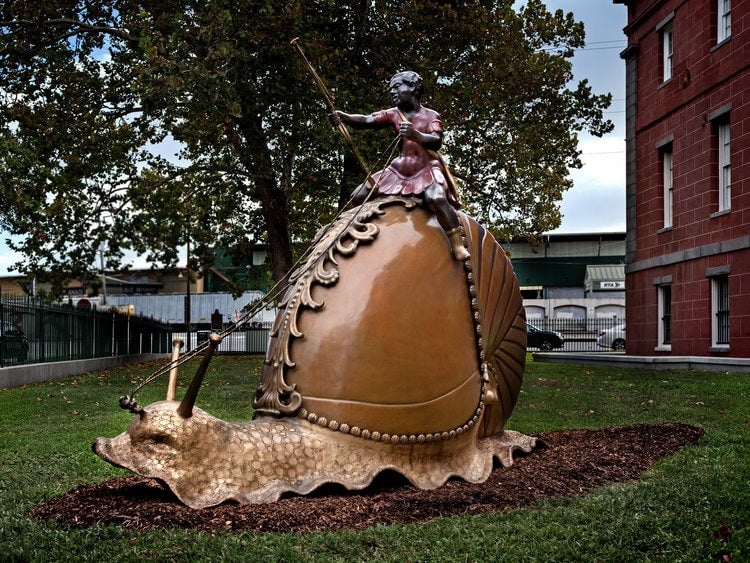Los Angeles-based curator Naima J. Keith came to Atlanta in early June 2019 as part of the Visiting Curator Series presented by Flux Projects. Alongside curator Diana Nawi, Keith is currently co-artistic director of the forthcoming fifth edition of the contemporary art triennial Prospect, set to open in New Orleans in 2020. She is also the newly appointed vice president of education and public programs at the Los Angles County Museum of Art, following previous positions at the California African American Museum and the Studio Museum in Harlem. A native of Los Angeles, Keith became attracted to art history and curatorial work while an undergraduate at Spelman College.
Before she was joined in conversation by curator Daniel Fuller at Atlanta Contemporary, I spoke with Keith over breakfast at a nearby café. Our conversation began with a question about Keith’s path to becoming a curator and her thoughts on curatorial education. Later, we discussed the pressures on artists to respond to our fraught political moment and Keith’s vision for Prospect.5. Our conversation was conducted in person in June 2019 and has been edited for publication.

Logan Lockner: Can you talk a little bit about what led you to your career as a curator and share any thoughts you may have about the ascendant role that curators occupy throughout our cultural sphere and the development of more targeted programs for educating them? Your alma mater Spelman College, for example, has introduced a very well-received curatorial studies program in recent years.
Naima J. Keith: I’m originally from Los Angeles, California. When I first got to Spelman in 1999, I wasn’t initially studying art; I started out as an [economics] major and changed to art—they had a concentration in art history, but not its own major—at the end of my sophomore year. I think my mom was a little freaked out by that. On one level, you’d think she wouldn’t be freaked out, because she’s a collector—she’s been collecting contemporary African American art basically my entire life, and she would drag me and my sister to museums as kids. I took an art history course at Spelman, and I fell in love. Learning about African American artists in a broader context, and hearing about some of the artists whose work my mom collected or who I’d met growing up in LA—people like Betye Saar and John Outterbridge—sparked a real interest for me.
Back then, Andrea [Barnwell Brownlee] was just getting started at Spelman, actually, and you could see that she already had a vision for what the museum could be and wanted to take it in a more contemporary direction. There was nothing like a curatorial program or focus yet, but she talked to art history students about the curatorial field as a career path. At that time, however, I thought you had to get a Ph.D. to be a curator, and so many of the people that I looked up to—people such as Lowery Stokes Sims, or others—had their Ph.D. So after Spelman, I went to UCLA for graduate school with the intention of getting a Ph.D. But after my master’s, I accepted a position at the Hammer Museum to work on Now Dig This!: Art and Black Los Angeles. I immediately said I wanted that job because it was working with Kellie Jones, who was based in New York and needed someone on the ground in LA. It was all the right things: a celebration of LA artists, an opportunity to look at artists of color who’d I already admired and studied in school. It felt like the job was written for me.
So Kellie and I worked together very closely on that show for three years, and I learned a lot about curating and curatorial process, and certainly about how academia influences an exhibition and how you think about the contribution that it makes to the field, but in my heart, I just lost interest in the Ph.D. The idea of sitting in an archive for hours and hours just did not excite me; it’s not my personality. Over time, I slowly left the program and decided not to finish the Ph.D. A master’s program or a Ph.D. certainly prepares you for a lion’s share of what we do as curators in terms of research, writing, thinking about how an exhibition functions and the way in which you write about objects. But the other side, how to organize an exhibition in terms of the logistical aspects, those are things you can learn on the job, of course. It’s important to think about exhibitions not just as academic case studies but rather all the different sides of putting them together. Can you actually get that object for your show? What are the insurance values? There are all these things that don’t necessarily factor in when you’re just critiquing the exhibition in an academic setting.

After leaving the Ph.D. program and spending three years at the Hammer, I went to the Studio Museum in Harlem, where I worked for five years. That was a fantastic experience for all the reasons you’d think it would be. The Studio Museum has such a long history of not just supporting artists but also curators. It has certainly become an institution that realizes it has the capacity to give young curators a real opportunity and a real shot, which I think is still an issue in our field, where it’s easy to stay in a position, or not get promoted, or stay in this weird middle phase where you’re not a curatorial assistant but you can stay an assistant curator for years and years and years. I think that the Studio Museum realizes the competitiveness and the lack of diversity at a number of museums, and that in order for us to become competitive for other positions that there needs to be a little bit of nurturing and career development. That was amazing. To work with Thelma [Golden] was, of course, a degree in itself. You’re not just learning about what it means to organize exhibitions but also how to support artists long-term and think about how you can be an advocate for their work, not just at the institution but in every sphere you’re in. It was at the Studio Museum that I was really able to hone in on my advocacy for artists from the West Coast—I’m from there, of course—and I felt there could be a sort of cross-country dialogue happening that wasn’t.
When my husband and I learned that we were having our daughter, we decided to move back to LA. At that time, the California African American Museum (CAAM) was also looking to radically change their program, so they approached me about taking on the deputy director position. At CAAM, I initially thought it was about changing the exhibitions. It became clear to me, however, that it was about the total experience: CAAM had become this hidden gem that maybe wasn’t as widely known to the city as it should have been. Being from LA, I really saw the institution’s potential. I think people have been rooting for CAAM for a long time, perhaps to become—for the lack of a better phrase—the Studio Museum of the West, especially in terms of a space that all different kinds of people feel comfortable in, all generations.
At CAAM, this idea of access became really important to me. I fully recognize that museum spaces are not comfortable for everyone; not just anyone can comfortably saunter into the High Museum or the MoMA or the Met. There is a level of intimidation, not just for people of color, but for any regular, everyday people. Rather than making people feel like they had to know about this particular artist or exhibition, we would meet you halfway. We would have food trucks, DJs, and the whole nine yards: not as a razzle-dazzle but just to say, (A) this is going to be fun, and (B) you can come for the food trucks and discover the artist. There’s not pressure to know why CAAM is showing Rob Pruitt; it’s about people feeling that this is a place that supports me.
When Michael [Govan] and I started talking about his vision for the education department [at LACMA] and the satellite locations that LACMA is going to open in the very near future, it really intrigued me, and I was game to work on a bigger challenge at a bigger institution. Again, being an Angeleno, LACMA really is the encyclopedic museum of the city, so when you think about impact—I mean, we welcome a million people each year. Thinking about the kind of presence and visibility that LACMA occupies in the lives of so many families and kids really excited me about coming there, and I’ve been there for about two months now.
LL: Considering how you started out at Spelman, in an environment that is really focused on women of the African diaspora, and having worked at these—perhaps, for a lack of a better term—identity-focused institutions such as the Studio Museum and CAAM, I’m reminded of a question I was asked by an artist a couple of weeks ago about whether the way in which people write about or talk about art has become too politicized. I sort of threw the question back at him and asked if it wasn’t also an issue of curation and the way that critics are responding to how exhibitions are presented now, as well as a broader reflection of the intensely politicized era in which we’re living.
On the other hand, there have been reviews of the 2019 Whitney Biennial published suggesting that it isn’t radical or political enough; I think the Art Newspaper said, “There isn’t a single revolutionary in the new Whitney Biennial.” And then, of course, artist Simone Leigh clapped back on Instagram—I’m sure you’ve seen that response. What does it mean for that question or accusation to be raised at this particular moment: are things too political, or are they not political enough? How do you think about these notions of radicality or revolutionary potential, perhaps especially within your history of working with African American artists?

NJK: This idea of artwork being too safe, or not radical enough—there’s a part of me that’s just like, “Let artists be artists.” If they want to be super radical and take on certain topics, then great, and if not, then great. It’s like expecting every woman to be up in arms about what is happening [with reproductive rights]—and it’s not to say that we’re not. But I think radicality happens in all different forms. There are ways to be radical without wearing a badge to say that’s what you’re doing. There are subtle or more covert ways of being radical, and everyone has different definitions of what that is. Would it have been more satisfying if radicality had been presented in a way that everyone understood it as such? What happened to subtlety, or allowing artists to make whatever they want?
Obviously this issue has been going on forever: you read Jack Whitten’s writings about his work and the expectations that people had for what he was making, or even someone like Charles Gaines, where people felt the work wasn’t radical enough or he wasn’t speaking to certain issues. But it’s ironic that now these are artists who we’re praising. I read a headline recently about how Howardena Pindell said she didn’t want to make work about Trump. It’s like, “Shit, I’m tired.” We have to exist. We have to make gestures and moves and decisions based on the world that we want to see and create, rather than using our platform every day to complain. I just come back to this question: radical enough for whom?
This is something we’re certainly thinking about for Prospect. It’s going to open a month before the [2020 presidential] election, and we don’t know what the conversation is going to be at that time. But are the artists we’re talking to now thinking about making work directly about Trump? No. Does that make our triennial any less radical because artists are not wanting to make a piece about the abortion debate or immigration or healthcare? No. It doesn’t mean they don’t want to take on topical things, but it may be done in a way that’s not so in-your-face. I know biennials and triennials face this expectation of speaking to what’s happening in the current moment, but it shouldn’t necessarily be didactic.
I get it, right? You turn on the news every day, and you look to artists to make work about what we’re experiencing. Oftentimes art sparks dialogue about a particular issue. But I just worry about our expectations that develop when they do so, or how you may measure what artists do as being radical enough.
LL: The edition you’re working on will mark the tenth anniversary of Prospect. I’m especially curious to hear about the collaborative model for the curation of this edition: you’re co-curating the triennial with Diana Nawi, who’s also based in LA. In March, an artistic directors’ advisory council was announced for Prospect, including figures such as MoMA curator Thomas Lax, United States Artists director Deanna Haggag, and New Orleans African American Museum curator Gia Hamilton, among others. Could you speak a little bit about the process of working on Prospect thus far?

NJK: Based on my conversations with Trevor [Schoonmaker] of P.4 and Franklin [Sirmans] of P.3, I knew the enormity of Prospect and what it demands on your life and your job—because we all maintain existing jobs in addition to curating Prospect—would be too much without a co-artistic director. The fact that Diana and I both live in LA is amazing because we’re able to meet face-to-face on a weekly basis. I’m here in Atlanta right now, but Diana is in New Orleans taking artists around and looking at sites, so it also just allows us to divide and conquer in a way that one person couldn’t do on their own. Most biennials and triennials are organized by groups, and the Whitney Biennial has been organized by multiple people forever. It just felt like a natural evolution for Prospect to follow that sort of model, and having a thought partner is so important.
In terms of our advisory committee, we wanted to choose some people who had already organized biennials or triennials before—people like Eungie [Joo] or Rita [Gonzalez] or Valerie [Cassel Oliver]. We also wanted to work with people of diverse backgrounds and think about how we could use those resources to get feedback on directions we’re taking. We assembled a group that we knew would be honest with us.
LL: How are you thinking about this issue of access that has become so important to you in relation to Prospect? A museum campus can be intimidating enough, but here you have an entire city with an existing population that might or might not have reservations about an international art triennial taking over New Orleans.
NK: Looking back at past editions of Prospect, we admired how previous installments had allowed residents to take ownership of more local projects. One of the more popular aspects of the first Prospect was that there was a bus that would transport people to the various venues, and that’s something we’re looking into. We’ve had a lot of conversations with local cultural stakeholders about their expectations for Prospect, and while we can’t fulfill every hope and dream, it’s important to maintain this position of active listening. We know we’re not from New Orleans, and we’re not going to act like we know it even after doing all this. Prospect is not just for visitors or tourists. It’s a triennial for everyone.
Prospect.5 is set to open in New Orleans, Louisiana, in October 2021.




